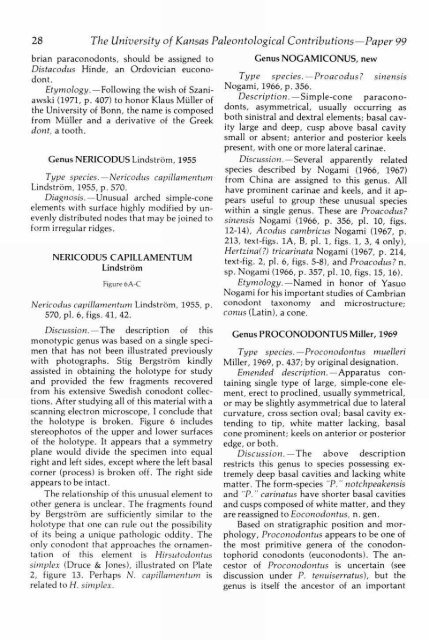View - KU ScholarWorks - University of Kansas
View - KU ScholarWorks - University of Kansas
View - KU ScholarWorks - University of Kansas
You also want an ePaper? Increase the reach of your titles
YUMPU automatically turns print PDFs into web optimized ePapers that Google loves.
28 The <strong>University</strong> <strong>of</strong> <strong>Kansas</strong> Paleontological Contributions—Paper 99<br />
brian paraconodonts, should be assigned to<br />
Dis tacodus Hinde, an Ordovician euconodont.<br />
Etymology. —Following the wish <strong>of</strong> Szaniawski<br />
(1971, p. 407) to honor Klaus Muller <strong>of</strong><br />
the <strong>University</strong> <strong>of</strong> Bonn, the name is composed<br />
from Muller and a derivative <strong>of</strong> the Greek<br />
dont, a tooth.<br />
Genus NERICODUS LindstrOrn, 1955<br />
Type species.—Nericodus capillamen turn<br />
LindstrOrn, 1955, p. 570.<br />
Diagnosis. —Unusual arched simple-cone<br />
elements with surface highly modified by unevenly<br />
distributed nodes that may be joined to<br />
form irregular ridges.<br />
NERICODUS CAPILLAMENTUM<br />
Lindstriim<br />
Figure 6A-C<br />
Nericodus capillamenturn Lindstreorn, 1955, p.<br />
570, pl. 6, figs. 41, 42.<br />
Discussion. —The description <strong>of</strong> this<br />
monotypic genus was based on a single specimen<br />
that has not been illustrated previously<br />
with photographs. Stig Bergstrom kindly<br />
assisted in obtaining the holotype for study<br />
and provided the few fragments recovered<br />
from his extensive Swedish conodont collections.<br />
After studying all <strong>of</strong> this material with a<br />
scanning electron microscope, I conclude that<br />
the holotype is broken. Figure 6 includes<br />
stereophotos <strong>of</strong> the upper and lower surfaces<br />
<strong>of</strong> the holotype. It appears that a symmetry<br />
plane would divide the specimen into equal<br />
right and left sides, except where the left basal<br />
corner (process) is broken <strong>of</strong>f. The right side<br />
appears to be intact.<br />
The relationship <strong>of</strong> this unusual element to<br />
other genera is unclear. The fragments found<br />
by Bergstrom are sufficiently similar to the<br />
holotype that one can rule out the possibility<br />
<strong>of</strong> its being a unique pathologic oddity. The<br />
only conodont that approaches the ornamentation<br />
<strong>of</strong> this element is Hirsutodontus<br />
simplex (Druce & Jones), illustrated on Plate<br />
2, figure 13. Perhaps N. capillamenttim is<br />
related to H. simplex.<br />
Genus NOGAMICONUS, new<br />
Type species. —Proacodus? sinensis<br />
Nogami, 1966, p. 356.<br />
Description. —Simple-cone paraconodonts,<br />
asymmetrical, usually occurring as<br />
both sinistral and dextral elements; basal cavity<br />
large and deep, cusp above basal cavity<br />
small or absent; anterior and posterior keels<br />
present, with one or more lateral carinae.<br />
Discussion. —Several apparently related<br />
species described by Nogami (1966, 1967)<br />
from China are assigned to this genus. All<br />
have prominent carinae and keels, and it appears<br />
useful to group these unusual species<br />
within a single genus. These are Proacodus?<br />
sinensis Nogami (1966, p. 356, pl. 10, figs.<br />
12-14), Acodus cambricus Nogami (1967, p.<br />
213, text-figs. 1A, B, pl. 1, figs. 1, 3, 4 only),<br />
Hertzina(?) tricarinata Nogami (1967, p. 214,<br />
text-fig. 2, pl. 6, figs. 5-8), and Proacodus? n.<br />
sp. Nogami (1966, p. 357, pl. 10, figs. 15, 16).<br />
Etymology. —Named in honor <strong>of</strong> Yasuo<br />
Nogami for his important studies <strong>of</strong> Cambrian<br />
conodont taxonomy and microstructure;<br />
conus (Latin), a cone.<br />
Genus PROCONODONTUS Miller, 1969<br />
Type species. —Proconodon tus muelleri<br />
Miller, 1969, p. 437; by original designation.<br />
Emended description. —Apparatus containing<br />
single type <strong>of</strong> large, simple-cone element,<br />
erect to proclined, usually symmetrical,<br />
or may be slightly asymmetrical due to lateral<br />
curvature, cross section oval; basal cavity extending<br />
to tip, white matter lacking, basal<br />
cone prominent; keels on anterior or posterior<br />
edge, or both.<br />
Discussion. —The above description<br />
restricts this genus to species possessing extremely<br />
deep basal cavities and lacking white<br />
matter. The form-species -P. - notch peakensis<br />
and "P. - carinatus have shorter basal cavities<br />
and cusps composed <strong>of</strong> white matter, and they<br />
are reassigned to Eoconodontus, n. gen.<br />
Based on stratigraphic position and morphology,<br />
Proconodon tus appears to be one <strong>of</strong><br />
the most primitive genera <strong>of</strong> the conodontophorid<br />
conodonts (euconodonts). The ancestor<br />
<strong>of</strong> Proconodontus is uncertain (see<br />
discussion under P. tenuiserratus), but the<br />
genus is itself the ancestor <strong>of</strong> an important
















